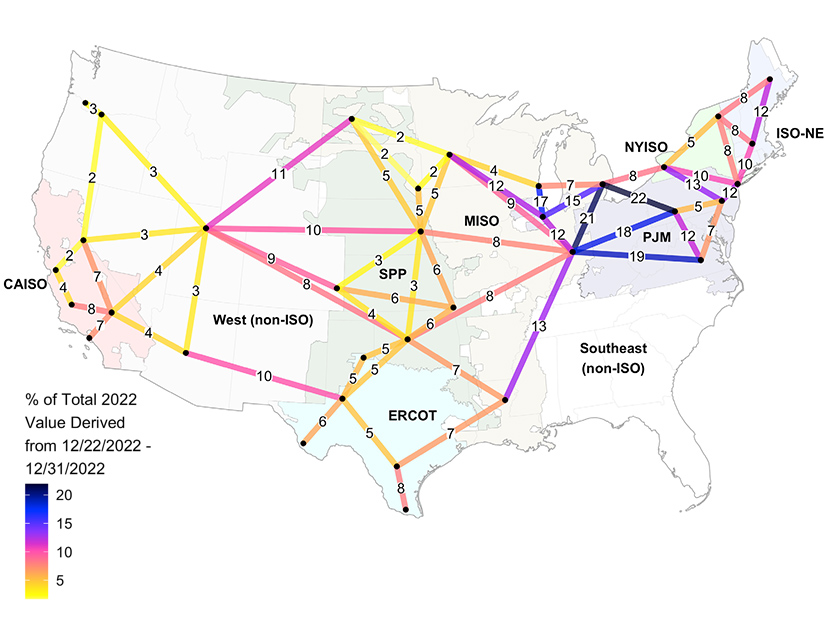
The U.S. electricity grid is often described as one of the greatest and most complex machines ever built. Hundreds of thousands of miles of wires connect our nation’s homes and businesses to our domestic energy resources, helping drive American prosperity and security over the last century.
But like any aging machine — particularly one designed to meet 20th century needs — some of its components are no longer operating efficiently. And these inefficiencies are costing American consumers on their utility bills and threatening access to reliable electricity.
Existing connections between grid regions are simply not utilized as well as they should be.
The power grid is generally broken up into regions. Regional grid operators rely primarily on power plants in their service areas to generate enough electricity for homes, schools, hospitals and businesses. The supply of power must meet demand at any given time to maintain grid stability and to keep the lights on.
There are also power lines that connect these regional networks, so a home in Cleveland may receive electricity generated by a wind farm outside Des Moines. This is especially beneficial for the Ohio homeowner if that wind farm is producing the cheapest power at that time. And this interregional connection is even more important if a winter storm forces several power plants in Ohio to stop operating. That transmission line will carry critical electricity needed to keep the heat and lights on in homes hundreds of miles away.
The value of interregional transmission capacity was especially evident during the deadly cold snap in February 2021 that slammed the central U.S. While Texas’s isolated grid was forced to shut off power to millions of people, grid operators in the Midwest and Great Plains avoided widespread outages by importing 15 times more electricity than Texas through interregional lines.
But the U.S. has few of these interregional power lines. And we are not using the existing capacity very efficiently. While new electricity-carrying lines are needed, they often can take up to a decade to plan and build because of complex siting and planning processes. As a result, it’s important to maximize the use of the existing system.
Regional grid operators have a clear opportunity to optimize the existing interties they share with neighboring regions. In fact, for nearly two decades, the oversight bodies that monitor Eastern regional grid operators have recommended that they do just that. It’s now well documented that the inefficient use of these connections continues to increase system costs and reduce reliability.
At times, despite the cost of power being significantly higher in one region than the other, electricity will flow from the more expensive market to the lower-priced market, raising system costs. In the Mid-Atlantic, this costly phenomenon occurred 48% of the time in 2022, according to the PJM Market Monitor. In the Midwest, MISO’s Monitor determined that more than 40% of transactions between its neighboring regions were “ultimately unprofitable” in 2021.
But some U.S. grid regions are using these interregional connections more efficiently. In the West, markets have optimized their interties, saving more than $4 billion since the inception of system changes almost a decade ago.
Optimizing the use of existing or new interregional transmission capability between grid operators in the Midwest, Plains and Mid-Atlantic would provide approximately $50 million to $60 million annually for every 1,000 MW of intertie capacity, according to recent analysis by the Brattle Group.
The failure to optimize interties means existing power infrastructure is underutilized, and the benefits of interregional transmission are not fully realized. Thus, there is less of an incentive to build the future interregional transmission lines our country desperately needs to ensure consumers can access clean, affordable power at all hours. Recent studies have shown that the U.S. needs to dramatically hasten the pace of interregional transmission line deployment to meet future electricity demand.
There are several paths FERC can take to improve the efficiency of the existing interregional system. FERC can require intertie optimization under existing federal law or act on a request from a regional grid operator. Given the well-documented savings that improving current inefficiencies would generate, the commission is well within its authority to require grid operators to optimize their interties.
We’re long overdue to optimize the capacity currently available. Doing so will enhance the grid today and help ensure that future investment efficiently powers America through the 21st century.
Nora Mead Brownell served on the Federal Energy Regulatory Commission from 2001 to 2006 and now serves as a Venture Partner at Clean Energy Venture Group.
